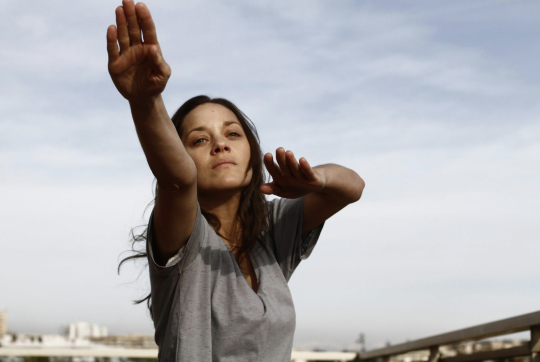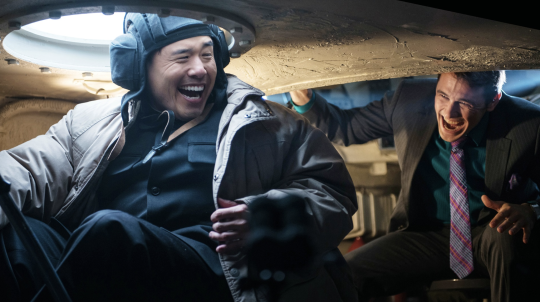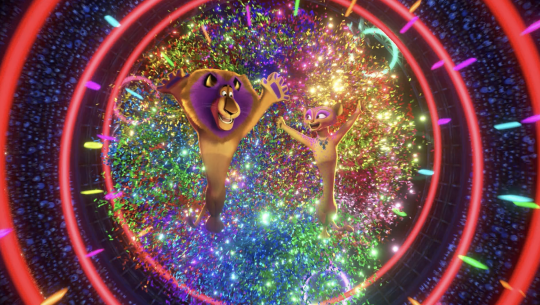Ignite the Light: How Katy Perrys Firework Brings Scenes From Three Very Different Movies to Life by Josh Bell
By Yasmina Tawil

When Katy Perry’s “Firework” begins playing for the first time in Jacques Audiard’s Rust and Bone, it’s not especially noticeable. The song is part of the background music at Marineland, the aquatic park where Stephanie (Marion Cotillard) works as an orca trainer, one of several upbeat pop songs that serve to get the crowd excited during the routine animal performances in the outdoor amphitheater. It’s only after the minute-long section of the song has ended, and the soundtrack has shifted to tense orchestral music, that it becomes clear how indelibly “Firework” will be seared into Stephanie’s psyche, probably for the rest of her life.
The presence of contemporary pop songs like “Firework,” especially in mainstream Hollywood movies, is usually unremarkable and often little more than an afterthought, with songs just as likely chosen for marketing purposes as for artistic ones. But filmmakers with strong visions can harness the undeniable power of a huge pop hit like “Firework” and transform it into an essential storytelling tool, as Audiard does in Rust and Bone and as the directors of the far more multiplex-friendly movies The Interview and Madagascar 3: Europe’s Most Wanted do as well. It may be a coincidence that the filmmakers behind all three movies chose “Firework” for the most pivotal and memorable moments in their films, but it’s no coincidence that Perry’s empowerment anthem has the ability to speak to artists with very different creative goals.
Written by Perry along with Ester Dean, StarGate, and Sandy Vee and taken from Perry’s 2010 album Teenage Dream, “Firework” is one of Perry’s biggest hits, and it seems tailor-made for the movies, with its soaring earworm chorus and its inspirational lyrics that are specific enough to stick in your mind (the singular use of “firework” is especially uncommon) but generic enough to apply to almost any situation involving believing in yourself and pursuing your dreams. It’s not necessarily a great song, but it’s the right song for what each of these films is aiming to convey at a particular moment.
The second time that “Firework” surfaces in Rust and Bone, about 50 minutes after the first, its significance is clear: Stephanie is now in a wheelchair, following an accident that left her legs severed below the knee. The choreographed performance between orcas and trainers, set to “Firework,” was the last thing she experienced before her terrible injury, and the song is now a symbol of the life she’s lost and has struggled to rebuild. Much of that rebuilding has come from her burgeoning relationship with Ali (Matthias Schoenaerts), an underground mixed martial-arts fighter and itinerant laborer who has shown her more compassion and patience than anyone else in her life. The two have just had sex for the first time, in a scene that is sweet and passionate and a little awkward, and Ali has left Stephanie’s apartment with a casual farewell that doesn’t match her clearly stronger feelings of attachment.
Vulnerable yet undaunted, Stephanie sits on her balcony, Audiard’s camera first capturing her from behind. As Audiard cuts to a side view of Stephanie, she slowly starts miming the hand motions from her aquatic performance, first in silence and then as “Firework” gradually fades in on the soundtrack. As it does in most instances in all three of these movies, the song begins here with the line “Ignite the light and let it shine,” sparking the light in Stephanie’s eyes as her hands are outstretched and open. The song builds to its chorus as her motions become more confident, forceful. Her expression goes from wistful to triumphant, her hands poised and powerful, pumping to the beat. As the song continues to play, Audiard cuts to Stephanie, using a cane and her new prosthetic legs, walking for the first time into the empty amphitheater where she used to perform. She’s finally found the inner strength to confront her trauma, and while a lot of that came from Ali, plenty of it came from Katy Perry, too.
There’s a surprising amount of emotional power to the use of “Firework” in Seth Rogen and Evan Goldberg’s The Interview as well, even if it first appears as the target of a somewhat obvious joke. Vain talk show host Dave Skylark (James Franco) and his more pragmatic producer Aaron Rapaport (Rogen) have traveled to North Korea to interview dictator Kim Jong-un (Randall Park), an apparent superfan of Dave’s vapid celebrity-interview show. They’ve also been tasked by a CIA agent (Lizzy Caplan) with secretly assassinating Kim, although Dave has started to bond with the lonely despot, who has a secret fondness for cheesy American culture.
What better representative for bubblegum American pop in the early ’10s than “Firework”? When Dave and Kim are sitting in a Soviet tank that Kim says was a gift to his father from Joseph Stalin, Dave turns on the internal sound system, to Kim’s protests, and soon “Firework” starts playing softly (beginning, of course, with “Ignite the light and let it shine”). Kim stammers that he’s never heard the song before, but Dave the ugly American loves Katy Perry, and immediately starts singing along. That opens the flood gates for Kim, who admits to loving margaritas and identifying with the opening line of “Firework.” “You know Dave, sometimes I feel like a plastic bag …” he begins, and Dave finishes: “Drifting through the wind?” Kim does a little dance, and their bond is solidified.
Rogen and Goldberg cap the joke by turning the volume up on “Firework,” shifting it from the tinny diegetic sounds of the tank’s internal speakers to blaring and pulsing on the soundtrack, over a montage of Dave and Kim triumphantly riding the tank through the adjacent woods, and then blowing up a bunch of trees as they sing along to Perry’s “Boom, boom, boom!” “Firework” goes from a secret guilty pleasure to the anthem of their friendship and their glee over wanton destruction.
It’s a silly, fun bit in a movie that mostly exists to turn serious geopolitics into silly fun, but that fun takes a dark (if still comedic) turn when “Firework” comes back near the end of the movie. Now disillusioned about their alleged friendship, Dave wants to expose Kim as a fraud, during the internationally televised interview. Pressing Kim to reveal his emotional weaknesses, Dave pulls out the one thing he knows will get a response: “I just have one more question for you: Do you ever feel like a plastic bag drifting through the wind, wanting to start again?” As Dave sings the lyrics, Kim breaks down crying, revealing to the world that he’s a scared little boy inside. If it’s possible to feel sympathy for a cartoonish version of Kim Jong-un in a gross-out comedy, then this is the point at which that happens.

Directors Eric Darnell, Conrad Vernon and Tom McGrath don’t have nearly as much on their minds for their use of “Firework” in the third Madagascar animated movie, but the song nevertheless provides the backbone for the movie’s most visually inventive sequence, probably the most memorable moment in the entire Madagascar series. For reasons that are far too convoluted to get into, the series’ main zoo-animal characters—lion Alex (voiced by Ben Stiller), zebra Marty (Chris Rock), hippo Gloria (Jada Pinkett Smith) and giraffe Melman (David Schwimmer)—are hiding out with the animals of a circus traveling through Europe, and they need to wow an American promoter in order to get a contract to perform in New York City (which will bring the zoo animals home).
After witnessing the sad state of the circus acts, the main characters take it upon themselves to overhaul the entire show, despite their complete lack of circus knowledge. There certainly isn’t a lot of realism in the Madagascar movies, but Europe’s Most Wanted takes things in an especially absurdist and surreal direction, even before the trippy “Firework” sequence, which is entirely divorced from physics or logic. The make-or-break performance opens with surly Russian tiger Vitaly (Bryan Cranston) attempting to re-create a legendary stunt that went wrong, as he jumps through a flaming hoop that looks about the size of a wedding ring. After he somehow manages that feat, the crowd goes wild, and Vitaly extinguishes the tiny ring of fire, picks up the baton that was holding the ring and places it in the ground—and the movie transforms into a kaleidoscopic dreamscape.
There’s no gradual fade-in as “Firework” starts here; this is not a movie interested in subtlety. Once again, it begins with “Ignite the light and let it shine,” and the light here is literal: There’s an explosion of color as Vitaly’s baton activates a swirling, multi-colored platform like something out of a Las Vegas Cirque du Soleil show, only reaching impossibly high, taller than even the tallest circus tent. There’s no sense of physical limitations as the movie presents a bear on a motorcycle riding perpendicular to the crowd in the stands; dogs on rocket-powered skates shooting out what look like actual fireworks; Alex and sultry jaguar Gia flinging themselves about on rings of pure colored lights (which then become cannons to shoot other animals into the air); Melman and Gloria walking tightropes that are simply beams of light; and elephants shooting multi-hued flames from their trunks. The crowd goes wild, but it’s impossible to tell where the crowd even is, in relation to the performers.
On the Europe’s Most Wanted DVD commentary track, the directors note that editor Nick Fletcher specifically cut the circus sequence to “Firework,” demonstrating how important the song was to the movie’s development. Rogen, too, notes the importance of “Firework” to The Interview’s creative process in his DVD commentary: “Katy Perry is fucking cool as shit, and the fact that she let us do this is cool as shit,” he enthuses in his typical blunt manner. For his part, Audiard is more reserved about Rust and Bone’s wheelchair “Firework” scene, although it’s easily the movie’s most emotionally powerful moment, and a distillation of Cotillard’s masterful performance, as she conveys Stephanie’s difficult journey in just a few looks and hand movements. It was Cotillard, Audiard says on the movie’s commentary track, who convinced him to shoot the scene, which was initially just two lines in the script that he wasn’t sure he wanted to include. He ignited the light, and then she let it shine.


